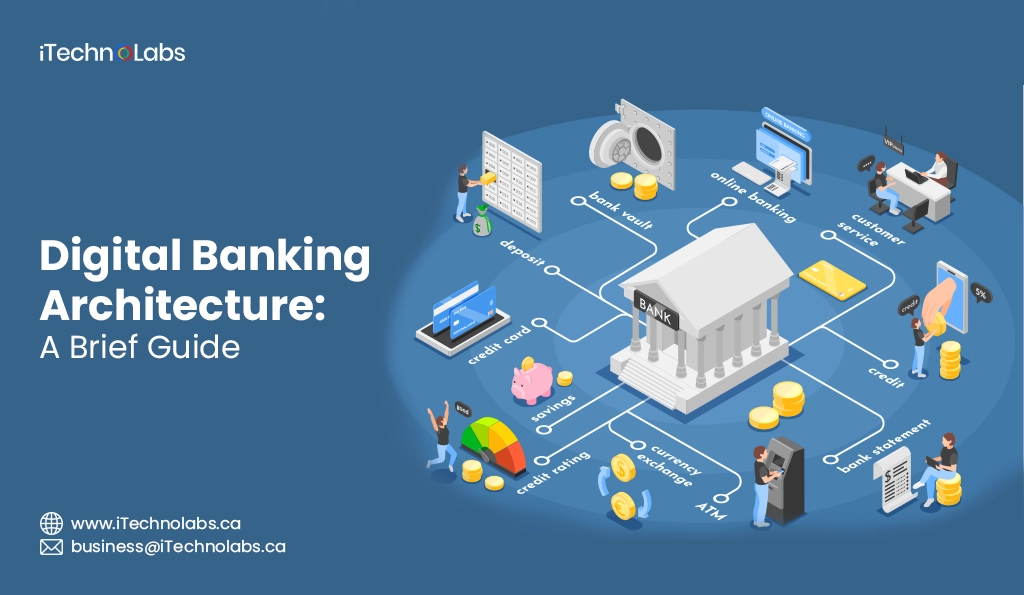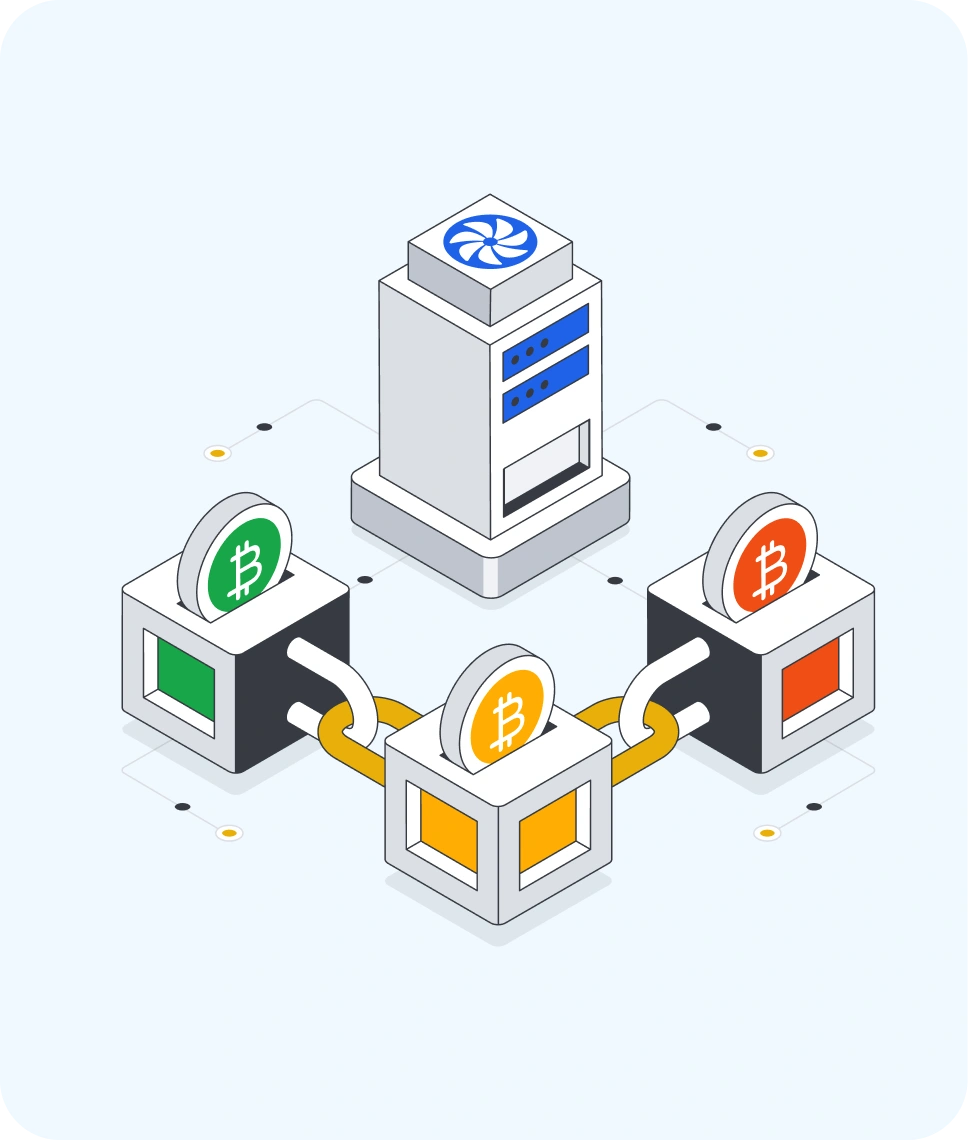Digital Bank changed how we fully control our money that it seems to be very old-fashioned now. Nowadays, click the screen to move money, ask for a loan, or what your financial needs are required and all at any time without going to the bank (what’s good!). Therefore, large banks are forced to change their ways and focus on becoming safer and providing a better user experience. Improvements include investing in better cyber security to protect our information, using artificial intelligence (AI) and data analysis are placed at the center of an individual proposal, and adopt a “blockchain” technique to eliminate fraud and increase openness. If the speed of change increases, banks want to meet customer expectations.
What is Digital Banking?
Digital banking refers to the form of technology that redefines the way customers access financial services and manage their funds through online transactions without the need for a visit to the bank branch. It makes such a variety of transactions available, usually related to checking balances, transferring funds, paying bills, or taking loans, all done by the convenience of using a smartphone, tablet, or computer.
To secure customer data, digital banking has put in place security measures such as encryption of data communication and two-factor authentication to protect sensitive information from online threats and unauthorized access. Meanwhile, these platforms are very convenient with easy-to-use mobile apps among customers that allow them to manage their finances on the go with ease and effectiveness.
Digital banking continues to grow in popularity as it steadily evolves with technology because of its ease of use and efficiency with which services are offered. Financial institutions are investing in new technologies, namely, artificial intelligence and blockchain, to secure applications with innovative features and to revolutionize how we perceive and carry out transactions with our finances.
Some Well-Known Facts About Digital Banking
Digital banking keeps redefining the financial services sector with greater convenience and accessibility. Recent studies point to increasing uptake and changing consumer preferences around the globe:
- Over half of the global population is projected to use digital banking services by 2026, underscoring the shift towards digital financial solutions.
- A significant 73% of banking customers engage with multiple banks beyond their primary institution, indicating a trend towards diversified banking relationships.
- A Deloitte survey revealed that 75% of bank customers worldwide utilize mobile or internet banking as their preferred method of access to financial services.
- Digital banking has also witnessed a substantial rise in use as a result of the COVID-19 pandemic, with individuals shying away from making physical trips to banks and instead going for online transactions.
Key Requirements for Digital Banking Architecture
Developing an effective digital banking architecture requires forward-looking thinking and ensuring that not only is the current expectation served, but so is future-proofing. Some of the fundamental requirements in the design of an effective, resilience-driven, customer-focused digital banking platform are set out below:
Cloud Readiness
New digital banks are required to embrace the cloud so that they have scalability, agility, and economic efficiency. Cloud infrastructures offer instant deployment of services, streamlined updates, greater disaster recovery capabilities, and optimized resource management that, in effect, offer an agile operating model.
Open-Banking Compliance
PDS2 compliance is very critical with respect to open banking. Open banking stands for transparency and innovation and allows customers to share their financial data with third-party providers, in which they can fully control the data access and security via standardized APIs. Compliance ensures cooperation and expansion in services.
API-First Approach
An API-first approach allows digital banks to construct adaptive ecosystems where internal and external applications can seamlessly talk to each other. APIs help integrate new technologies, third-party services, and partners quickly, with the benefit of modular and scalable architecture that can be evolved according to changing customer needs.
Self-Servicing Capabilities
Customer empowerment for self-service capacities is the next answer in user experience improvement. Features such as opening an account online, end-to-end loan approval, digital onboarding, and automated customer support decrease reliance on physical branches and give users more control over their finances along with offering them convenience.
Flexibility & Configurability
A modular and configurable architecture enables digital banks to modify and transform rapidly in response to market fluctuations, regulatory needs, and consumer demand. Modular design philosophies, microservices design, and low-code/no-code platforms facilitate simple updates, customizations, and scaling without extensive system redesigns.
Transparency
Transparency underpins trust with customers. Communication about fees, data usage policies, transaction processes, and dispute resolution mechanisms is clear, and this leads to tighter relationships. Also, transparent backend operations contribute to improved regulatory compliance and operational effectiveness.
Data Digitization
Transformation of legacy, paper-based banking operations into digital forms is essential for operational effectiveness. Digitization of data not only speeds up processing of transactions but also increases data analytics functionality so that banks can provide personalized services, enhance decision-making, and ensure compliance more efficiently.
24/7 Operation with Real-Time Processing
Today’s customers expect banking services to be available around the clock. Implementing a resilient, real-time processing system ensures immediate transaction execution, real-time fraud detection, instant notifications, and seamless customer service. This round-the-clock availability is vital for maintaining customer satisfaction and competitiveness.
Types of Digital Banking Architecture
Different types of digital banking architecture are employed by financial institutions to offer online services to their customers. Some of the most prominent ones are:
1. Client-Server Architecture
Such architecture can have a very centralized server that provides services to its clients via the internet or through mobile application services. It can be an interface through which access can be gained to account balances, transfer of funds, payment, etc. All information in the account for the customer will be stored securely within the central server. It will include transaction history and personal information regarding the customer. Logging in with credentials will provide access to such data by customers. Hence, sensitive information remains accessible only by authorized users. The centralization of the system makes data integrity and more accessible use in upkeep and maintenance.
2. Peer-to-Peer Architecture
A primarily decentralized network can be used as a banking architecture for facilitating transactions. In this case the system is made peer-to-peer, which means that it is a client-server system without a central server, since all communication made will be done via clients. Each client here acts as a server for itself and as a client since these nodes share resources among themselves and use each other’s services. Therefore, this architecture totally eliminates the need for a central server, thus making it cost-effective in operations and infrastructure maintenance. In addition to that, this redundancy also enhances efficiency as it makes possible the elimination of single points of failure. On the other hand, it comes up to pose challenges in security as well as data management, consequently making sure about the integrity and confidentiality of transactions, requiring strong encryption methods and consensus systems. Data management arms and makes operational complexities because the whole decentralized system needs to undergo continuous synchronization and verification of data across all nodes present within the network.
3. Distributed System Architecture
When it comes to distributed system architecture, the bank system is divided into smaller-scale subsystems or applications, each distributed over numerous servers. All these subsystems interact with each other via an interface for exchanging messages in order to execute varying banking operations. This method enables the use of resources more efficiently and greater scalability. With increased load, new servers can be introduced to take up the extra load without affecting the whole system. Additionally, this design minimizes the risk of system failure since it spreads the work across multiple servers rather than having one server perform all operations.
Layers in the IT Architecture of a Modern Digital Bank
A contemporary digital bank consists of various layers, each playing its own role. These layers harmoniously come together to deliver an uninterrupted and safe banking experience for customers. The various layers in the IT architecture of a contemporary digital bank are as follows:
1. Back-end: Running on the Core Banking System
The back-end layer is the backbone of the banking system. It has the principal servers and databases that conduct all transactions relating to finances and maintain customer information. The layer performs the operations of payment processing, accounts handling, and balancing the customers. It is also charged with upholding the security and integrity of all the transactions by implementing sound encryption processes.
2. Middleware: Connecting the Front-end, Back-end, and Business Apps
To provide a middleware layer crucial to the functioning of the front-end, back-end, and business applications of a digital bank, it will act as an intermediary, allowing seamless communication and integration between the different layers while keeping all the data synchronized and consistent across the complete system. Synchronization with all the layers is imperative for the integrity and reliability of business operations in terms of banking. It will safeguard against discrepancies, which give rise to possible errors. This would also support scalability by adding new services or applications without any disruptions associated with existing business processes. This could either introduce new payment gateways, advanced security protocols, or completely new customer service tools, all of which will be enveloped into the existing middleware layer so that the integration is done smoothly and efficiently without disrupting the business. Thus, it acts as the strongest backbone for a digital bank as it helps it remain competitive and in synchrony with the ever-changing needs of the customers.
3. Front-end: Providing the Customer Experience
The front-end layer is that which engages customers with online banking services. It includes user interfaces, such as websites, mobile applications, and other digital platforms. With this layer being critical in providing customer experiences, it determines how user-friendly, efficient, and enjoyable it is for clients to conduct their financial transactions. A good front end not only provides an aesthetically appealing interface but also makes simple all the functions of necessary use. Features such as biometric authentication, personalized dashboards, and timely alerts can add much to the experience of customers with convenience, security, and transparency. Digital banks should continuously work on their front end for innovations to keep pace with dynamically changing customer preferences and expectations.
4. API layer: Connecting Internal and External Apps
The API layer acts as the intermediary between the front-end and the back-end layers, allowing communication and information interchange among various applications. APIs (Application Programming Interfaces) allow digital banks to connect their internal systems to external services such as third-party payment processors or financial management tools. This way, customers are able to use various services via one platform without switching between apps or websites. APIs also allow digital banks to cooperate with other enterprises in providing value-added services, such as personal financial consulting or rewards programs.
Also, read: POS System Requirements Specification & Checklist For 2025
Technology Stack for Digital Banking
The digital banking technology stack consists of core software and hardware components that complement each other to provide a smooth and secure experience to the users:
1. Java and Spring Framework
Java is a common language in banking applications due to its strength, security, and platform independence. The Spring Framework eases development with capabilities such as dependency injection, data access, and web services, facilitating scalability and maintainability.
2. Spring JDBC and Hibernate
These frameworks support data access layers that enhance the database operations with the capabilities of connection pooling, caching, and transaction management. They optimize performance and reliability.
3. Zimbra
Zimbra is open-source email and collaboration software employed for inter-bank communication. It provides such features as email, calendar, and file sharing with robust security, including encryption and multi-factor authentication.
4. MongoDB
MongoDB is a NoSQL database employed due to its flexibility and scalability. MongoDB processes unstructured data well, is suitable for distributed architecture, and has the ability to modify schema without taking the system down, hence being perfectly suited for high-performance banking systems.
5. JPA
Java Persistence API (JPA) eases data handling in Java-based applications by offering object-relational mapping (ORM) support and minimizing SQL queries. It offers secure and stable handling of data in digital banking systems.
Advanced Technologies Driving Innovations in Digital Banking
The fate of Digital Bank is determined by a number of innovative technologies. In order to remain competitive and meet changed customer requirements, today’s digital banks must continuously use and include these innovations in their system. Some of the most important technical drivers inspire digital banking system have been mentioned below:
API Platforms for Open Banking
Open banking efforts capable of API platforms change how to work with third-party suppliers and banks. By allowing safe and standard APIs, banks are able to distribute customer-legal data with fintech organizations, and support various price-added products such as budget management, investment insight and non-traditional lending platforms. API platforms improve innovation, competition and customer-focused solutions, leading to the opportunity to produce on their ecosystems and innovate their proposals without developing them all internal.
Artificial Intelligence & Machine Learning Innovations
Artificial Intelligence (AI) and Machine Learning (ML) are at the heart of digital banking transformations. Specific innovations include:
- Personalized Financial Services: AI analyzes customer behavior and transaction history to offer tailored financial advice, product recommendations, and personalized investment strategies.
- Fraud Detection and Prevention: ML models detect anomalies and suspicious activities in real-time, helping to proactively identify and prevent fraud.
- Chatbots and Virtual Assistants: AI-powered chatbots provide instant, 24/7 customer support, helping users with queries, transactions, and account management while reducing operational costs.
- Credit Scoring and Risk Assessment: ML algorithms analyze alternative data sources to evaluate creditworthiness, enabling faster and more inclusive loan approvals.
By leveraging AI and ML, digital banks can significantly enhance user experiences, streamline operations, and offer smarter, data-driven services.
Robotic Process Automation (RPA)
Robotic Process Automation (RPA) is revolutionizing backend operations by automating repetitive and rule-based tasks. In digital banking, RPA is utilized to:
- Automate KYC (Know Your Customer) Processes: Quickly verify customer identities by extracting and validating information from documents.
- Streamline Compliance and Reporting: Automatically generate regulatory reports and ensure adherence to compliance standards with minimal manual intervention.
- Enhance Transaction Processing: Accelerate back-office operations such as payment processing, account reconciliation, and customer onboarding.
RPA not only reduces operational costs but also minimizes errors, improves accuracy, and frees up human resources to focus on higher-value, strategic tasks.
Important Article: Zillow API Cost: Benefits & Factors To Use it
How to Design the IT Architecture for a Digital Bank
When designing the IT architecture for a digital bank, several key considerations need to be taken into account. These include:
1. Security
Safety should be top priority when designing Digital Bank architecture. This involves the implementation of various measures such as firewalls, infiltration detailed systems and encryption protocols to protect sensitive customer data from cyber threats. Firewalls act as a barrier between reliable and incredible networks, while infiltration detection systems monitor and analyze network traffic for signs of suspicious activity. Encryption protocols ensure that the data is safely transferred and stored, making them unlimited to unauthorized users.
In addition to these technical measures, it is important to serve regular security audits and updates to keep the system strong against new dangers. Safety Audit helps you identify weaker and ensure compliance with industry standards, while timely updating of any detected deficiencies. Employees’ training is also necessary with safety practices to prevent the dangers of inside and promote the culture of safety awareness in the organization. Together, these strategies create a comprehensive approach to protect the infrastructure of a digital bank and to maintain the customer’s trust.
2. Standards Compliance
Digital banks should follow different regulatory standards operating globally, such as General Data Safety Regulation (GDPR) and Payment Card Industry Data Security Standard (PCI DSS). These rules are designed to protect consumer data and secure transactions. Therefore, when designing IT architecture, it is important to ensure compliance with all relevant rules. This may include strong data encryption methods, strict access checks and extensive audit paths to prevent customer datatia protection and unauthorized access. In addition, regular security assessment and updated are necessary to adapt to developing threats and maintaining compliance. To ensure that these measures not only help protect sensitive information, but also build trust with customers, eventually contribute to the bank’s long-term success.
3. Agility
In today’s fast-paced digital scenario, agility is necessary for any organization to bloom. Digital banks in particular must be sufficient enough to be sufficient for market conditions and customers’ demands quickly. This requires a flexible IT architecture that can easily integrate new techniques and services without disrupting existing operations. Cloud-based solutions are often preferred options for digital banks as they provide scalability, cost-effectiveness and increased agility. By taking advantage of cloud computing, digital banks can quickly distribute new services, and secure data security and compliance.
4. Resilience
The flexibility is closely related to the agility and refers to the ability of Digital Bank’s IT architecture adapted to the changed business needs. This involves adjusting new products and services, as well as scaling up or down depending on the customer’s demand. To achieve this flexibility level, digital banks must use a modular approach in their IT architectonic designs. This involves dividing complex systems into small, interacted modules that can be easily changed or replaced without disturbing the entire system. By doing this, digital banks can quickly respond to market changes and stay ahead of their rivals.
5. Scalability
Scalability is an important factor for digital banks as they continue to increase and expand the customer base. It refers to the possibility of an IT infrastructure to handle user traffic and computer volume without compromising performance or security. As digital banks attract more customers and offer new services, the IT system must initially be able to meet these requirements. Cloud-based solutions are once again a valuable tool to achieve scalability when providing resources on request that can e
Examples and Case Studies
To better understand the importance of maintaining digital banking systems, let’s take a look at some examples and case studies.
1. BBVA (Banco Bilbao Vizcaya Argentaria)
BBVA, a Spanish multinational company in financial services, quickly recognized the need for digital change. In 2015, he launched his Mobile Bank app, which allowed customers to carry out most bank transactions from his phone. The app also included properties that alert real-time and personal recommendations based on customer data. With the success of its mobile app, BBVA has expanded its digital offers to open an online account with bank advisors and includes video consulting.
2. Monjo
The British-based Digital Bank, Monzo, has gained popularity for its user-friendly apps and innovative features. One of their unique offers is “POTS”, which allows customers to create underwater for specific savings goals. They also provide real-time information and use artificial intelligence to help customers help their money more efficiently. The success of Monjo suggests how to invest in user-centered design and constant improvement of the customer experience can lead to satisfied and loyal customers.
3. PayPal
PayPal has a large online payment system, and has also used digital banking strategies to stay ahead in the competing financial technology market. They have implemented advanced security measures to protect customer data and money, including two-factor authentication, SSL encryption and real-time surveillance for suspicious activities. These strong security protocols ensure that both personal and financial information are protected from potential threats.
In addition to security, PayPal provides a user-friendly interface for immediate transfer and spontaneous transactions, making users convenient to send and receive money, make online shopping and easily manage their accounts. His mobile app is designed for the Banking facility on the go, which provides more services from bill payment to international money transfer.
As a result of these extensive properties and a commitment to continuous improvement, Peepal has acquired more than 361 million active accounts worldwide, and strengthened its position as a reliable and reliable payment platform. His innovative approach to digital banking continues to attract new users and maintain loyal customers, contributing to their continuous success in the industry.
Are you planning to build a Digital Banking Architecture?
Conclusion:
As the digital landscape evolves, it has become necessary for financial institutions to build a high demonstration, safe and scalable digital bank platform. The modern digital bank architecture requires spontaneous integration in the system, focusing on user experience and implementation of strong security measures to protect sensitive customer data. Constant innovation, agility and customer-focused strategies are important to remain competitive. Institutions that invest in adaptive, flexible digital infrastructure will be better equipped to streamline operations, increase the customer’s busy and provide banking experience for the future.
Also read: VPN App Development: A Detailed Guide
FAQs
1. What are the three teams of digital bank architecture?
Digital banking architecture has three primary layers with front, middleware and back-end layers. Front-end provides the customer interface, ensures smooth communication between the intermediate system and manages core banking processes such as back-end management, transactions and data security.
2. What is the architecture of Digital Bank?
The architecture of a digital bank includes several interconnected layer-T applications, intermediate services, core bank-back-end systems and APIs. This design ensures the comfortable customer experience, secure data management, scalability and easy integration of new techniques, while maintaining operational efficiency and regulatory compliance.
3. What is architecture in bank?
The architecture in bank refers to the structural structure that combines all technology systems and procedures in a bank. This defines how digital platforms, databases, applications and security protocols work together to distribute safe, efficient and customer-focused financial services in different digital and physical touch points.
4. What is digital banking infrastructure?
Digital bank infrastructure technology is a combination of platforms, cloud services, APIs, databases, cyber security frameworks and frontend applications that enable banks to offer online financial services. It supports activities such as mobile banking, fund transfer, loan applications and personal services without the need for material drainage.
5. What is the architecture of the banking system?
The architecture of the banking system includes several integrated layer-core banking system for the course, intermediate product for service orchestration and front-end interface for customer interaction. It also includes APIs for integration with third-party services, which ensures a flexible, scalable and safe environment for modern economic activity.
6. What is the structure of the digital bank?
The structure of a digital bank is modular and layered, which usually consists of a customer-face-front-end (mobile apps, website), intermediate products for process management, a strong rear and core system and an API layer for external integration. This structure promotes agility, real-time operations and an enlarged customer experience.
7. Which architectural style is most appropriate for a banking software?
A microsar-wise architecture is often considered most suitable for modern banking software. This allows individual components to operate independently, making the system more scalable, flexible and easy to maintain. Microses also enable rapid integration of new features, improves safety and continuously supports continuous innovation in digital bank platforms.











